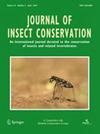古树、老树和其他被列为野生蜜蜂(Apis mellifera)栖息地的树木
IF 1.9
3区 农林科学
Q2 ENTOMOLOGY
引用次数: 0
摘要
野生蜜蜂(Apis mellifera)自然地在其活动范围内的老树上筑巢,但这一重要的筑巢栖息地正在全球范围内减少。在这里,我们确定了英国野生蜜蜂群落使用古树、老树和其他列出的树木作为筑巢地点,并调查了树木大小、属和管理对占用的影响。使用林地信托基金会(一个保护和促进英国树木的慈善机构)的古树清单(ATI)对英格兰东南部的1000多棵特殊利益树(tsi)进行了调查。2%的tsi和4.4%的tsi有蛀牙,被野生蜜蜂占据。占用率与树径正相关,这是令人惊讶的,因为整个样本的平均直径已经达到1.3 m。野生栖息地占据甜栗树(Castanea sativa)的频率比预期的要高(7%对2%),可能是由于它们的平均直径大(1.6 m)和树腔比例(73%)。被占用的树洞(包括非ati树)高度范围为0 ~ 18.2 m,中位数为6.8 m,入口大小范围为2.2 ~ 322 cm 2,中位数为33.8 cm 2,入口朝向与随机无显著差异。本文章由计算机程序翻译,如有差异,请以英文原文为准。
Ancient, veteran and other listed trees as nest sites for wild-living honey bee, Apis mellifera, colonies
Abstract Wild-living honey bee ( Apis mellifera ) colonies naturally nest in old cavity-bearing trees throughout their range, but this important nesting habitat is in global decline. Here we determine the use of ancient, veteran and other listed trees as nest sites by wild-living honey bee colonies in Britain and investigate the effect of tree size, genus and management on occupancy. Over 1,000 trees of special interest (TSIs) were surveyed in southeast England using the Ancient Tree Inventory (ATI) of the Woodland Trust, a charity that protects and promotes trees in Britain. 2% of all TSIs and 4.4% of TSIs with cavities were occupied by wild-living honey bee colonies (n = 21). Occupancy positively correlated with tree diameter, which is surprising given that the overall sample already had a large mean diameter of 1.3 m. Wild-living colonies occupied sweet chestnut ( Castanea sativa ) more frequently than expected (7% versus 2% overall), probably due to their large mean diameter (1.6 m) and proportion of trees with cavities (73%). Heights of occupied tree cavities (including non-ATI trees) ranged from 0 to 18.2 m with a median of 6.8 m, entrance size ranged from 2.2 to 322 cm 2 with a median of 33.8 cm 2 and entrance orientation was not significantly different from random.
求助全文
通过发布文献求助,成功后即可免费获取论文全文。
去求助
来源期刊
CiteScore
3.60
自引率
10.50%
发文量
76
审稿时长
6 months
期刊介绍:
The Journal of Insect Conservation is an international journal devoted to the publication of articles concerned with the conservation of insects and related invertebrates. The Journal of Insect Conservation publishes papers on all aspects of conservation and biodiversity related to the insects and closely related groups such as Arachnids and Myriapods, including ecological work which has conservation implications. Research papers may address the subject at the community, population or species level, may cover aspects of behaviour, taxonomy or genetics, be theoretical or practical, and be local or global in nature. Review articles are welcome as well as points of view which are likely to stimulate debate. From time to time the journal will publish Special Issues on specific subject areas which are the focus of current research. Proposals for such issues are welcome.

 求助内容:
求助内容: 应助结果提醒方式:
应助结果提醒方式:


